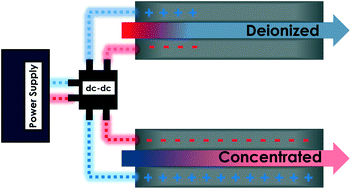Energy recovery in capacitive deionization systems with inverted operation characteristics†
Abstract
Capacitive deionization (CDI) operated under inverted mode involves electronic charging and discharge steps with corresponding ion concentration and desalting coupled with simultaneous energy storage. In this work, an energy recovery system derived from a Ćuk dc–dc converter is explored to transfer the energy stored from one inverted capacitive deionization (i-CDI) cell during the electronic discharge step to another during the charge step, decreasing the overall energy requirement for capacitive water desalination. The i-CDI cell, a subset of CDI architecture operated in an inverted mode, is improved by incorporating ion-selective membranes to allow inverted membrane capacitive deionization (i-MCDI), leading to enhanced charge storage achieved with reduced energy input. For example, in comparison to i-CDI that requires ∼12 J g−1 of energy input, the i-MCDI cell requires only 8 J g−1. By incorporating the recovery system, the energy penalty can be reduced to only require ∼8 and 4 J g−1 for i-CDI and i-MCDI cells, respectively. Improvement in energy recovery was shown to be achieved by reducing charge leakage, with the i-MCDI cell showing up to 3 times the leakage resistance of the i-CDI cell.

- This article is part of the themed collection: Capacitive deionisation and electrosorption 2020


 Please wait while we load your content...
Please wait while we load your content...
